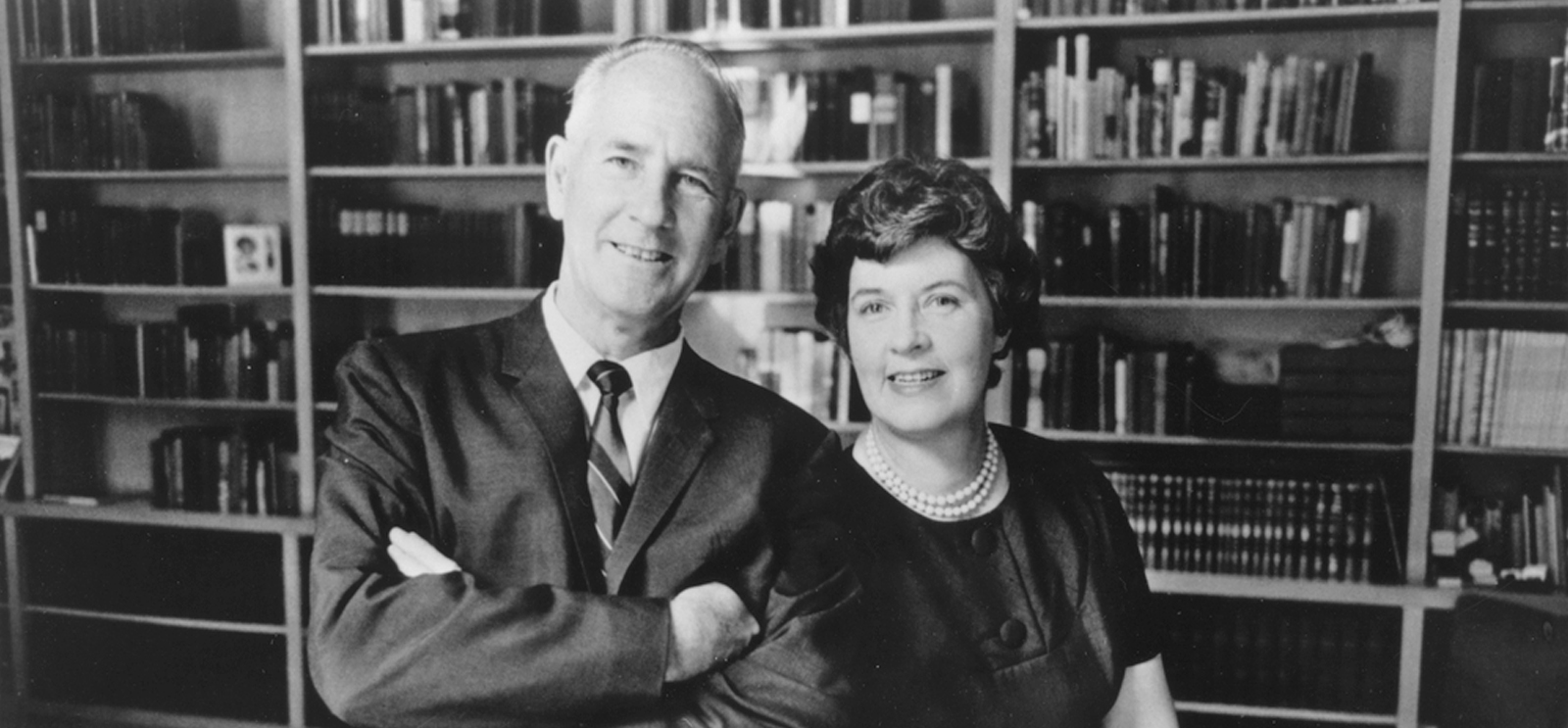
University of Chicago president George W. Beadle (1961–68) and his wife, author and civic leader Muriel McClure Beadle, in the library of the president’s house. (UChicago Photographic Archive, apf1-00447, Special Collections Research Center, University of Chicago Library)
A peek inside the president’s house—in 1961
An ugly rug, a stolen Tropical Hut planter, and why the bust of Silas J. Cobb is displayed in such an odd location.
George Beadle served as president of the University of Chicago from 1961 to 1968. His wife Muriel (1915–1994), a journalist and civic organizer, published a number of books, including These Ruins Are Inhabited (1961), a study of life at Oxford University; The Fortnightly of Chicago: The City and Its Women 1873–1973 (1973); and The Cat: History, Biology, and Behavior (1977). She cowrote the book The Language of Life (1966) with her husband, a Nobel Prize–winning geneticist.
When Mrs. Beadle arrived at UChicago in the spring of 1961, her first task was to settle into the president’s house. She took a dim view of the taste of Maude Hutchins, wife of former president Robert Maynard Hutchins, who was responsible for what she tactfully refers to the “1939 remodeling.”—Carrie Golus, AB’91, AM’93

[[{"type":"media","view_mode":"media_original","fid":"3926","attributes":{"alt":"","class":"media-image","height":"457","typeof":"foaf:Image","width":"500"}}]] The president’s house, built by Henry Ives Cobb. The front porch was removed after 1929. (UChicago Photographic Archive, apf2-05933, Special Collections Research Center, University of Chicago Library)
The library was “the prettiest room” in the place—not that it was anything like Cobb’s design. In the 1939 remodeling, the room had been gutted, beams removed, small Gothic-arched windows replaced with enormous rectangles of glass, and a sleek ivory marble mantel installed. What remained of the furnishings were some dirty white upholstered furniture and draperies and a huge rug of white rough wool, splashed with gargantuan flowers and foliage in hot orange, red, maroon, and several shades of green. When this riot of tropical color had first burst upon my view, I was feeling virtuous because I had just saved the University a pot of money by deciding to keep some upstairs carpeting in a color that I disliked. So I said to the University architect, as we stood in the doorway of the library, “Good grief! That thing has got to go!” “All right,” he said. “But I think you ought to know that this rug was handmade in Morocco, cost five thousand dollars, and was given to the University by the alumni.” “By the alumni?” “So I have been told.” I gulped. “Well, in that case,” I said, “I simply love it.”[[{"type":"media","view_mode":"media_original","fid":"3927","attributes":{"alt":"","class":"media-image","height":"616","typeof":"foaf:Image","width":"500"}}]] Robert Maynard Hutchins (president and later chancellor, 1929–1951) and Maude Hutchins in front of the president’s house (and since demolished front porch) in 1929. (UChicago Photographic Archive, apf1-05011, Special Collections Research Center, University of Chicago Library)
Therefore the library had been redecorated to enhance the rug. The chairs were now dark green or black; new green-striped draperies had been hung; and a stormy green and gray landscape by Innes had been transferred from the dining room to hang over the mantel. Finished, it was a handsome room. (And my pleasure in it was not diminished some months later when the myth of the Moroccan rug was exploded by that courtly gentleman Harold H. Swift. His memory was a kind of supplement to the University archives. He had been chairman of the Board of Trustees during the administration of Robert M. Hutchins, and when he overheard me telling someone about the history of the rug, he said, “I’m afraid that’s not quite right. The rug was made in India, it cost seven hundred and fifty dollars, and it was purchased at Marshall Field’s by Mrs. Hutchins.”) In one corner of the same room we had installed a huge philodendron in a blond oak planter transferred from elsewhere in the house and stained dark brown. There was a tale in connection with it, too. Lawrence Kimpton, George’s immediate predecessor—who had resigned in 1960 to take a job in industry—told us how touched he and his wife Marcia had been the year that a group of undergraduates had serenaded him on his birthday. (Even in the 1950’s, the rapport between university presidents and university students had not been so close that one took for granted a birthday serenade.) In addition, the kids had given him the planter. The Kimptons were overcome with gratitude. The next day they discovered that the students had stolen it from The Tropical Hut, a neighborhood eatery. “But,” Larry assured me as he wound up the story, “when we returned it, the people at The Hut said it was an honor to have their stolen property in the President’s House. So take good care of it.”* *And we too were to receive a gift of stolen property. Or perhaps I should say “borrowed.” One day we found on our doorstep—in a crate rather than in the traditional foundling basket—the marble bust of Silas J. Cobb (by Lorado Taft) that had disappeared from Cobb Lecture Hall some years before. I can only guess as to where his bust had been when it was “away,” but suspicion most logically falls on one of the fraternities. Cobb is now back on his pedestal in Cobb Hall—high above a door, where a ladder is required for access.[[{"type":"media","view_mode":"media_original","fid":"3928","attributes":{"alt":"","class":"media-image","height":"601","typeof":"foaf:Image","width":"500"}}]] The bust of Silas J. Cobb, back in Cobb Hall where he belongs. (UChicago Photographic Archive, apf2-01716, Special Collections Research Center, University of Chicago Library)

